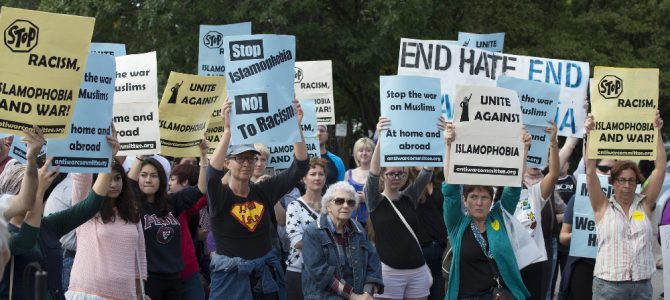
For the sake of campus protestors and their professors across the country, it’s time to make something clear: there’s no such thing as hate speech.
That should go without saying, since freedom of speech and free inquiry is supposed to be what college is all about. But the recent spate of violent student protests, from the University of California at Berkeley to Middlebury College in Vermont, have been met with a collective shrug from an alarming number of college students, professors, and administrators who seem to be under the impression that violence is okay so long as its purpose is to silence “hate speech.”
By hate speech, they mean ideas and opinions that run afoul of progressive pieties. Do you believe abortion is the taking of human life? That’s hate speech. Think transgenderism is a form of mental illness? Hate speech. Concerned about illegal immigration? Believe in the right to bear arms? Support President Donald Trump? All hate speech.
But in fact, there is no “hate speech” exception to the First Amendment. The answer to the question, “Where does free speech stop and hate speech begin?” is this: nowhere. For the purposes of the First Amendment, there is no difference between free speech and hate speech. Ideas and opinions that progressive students and professors find offensive or “hateful” are just as protected by the Bill of Rights as anti-Trump slogans chanted at a campus protest.
‘Fighting Words’ Are Not Hate Speech
There are, of course, certain kinds of speech that are not protected by the First Amendment. But those have nothing to do with hate speech, which has no legal definition. For example, there’s an exception for “fighting words,” which the courts have defined as a face-to-face insult directed at a specific person for the purpose of provoking a fight.
But fighting words can’t be expanded to mean hate speech—or even bigoted speech. In the early 1990s, the city of St. Paul tried to do just that, by punishing what it considered bigoted fighting words under its Bias-Motivated Crime Ordinance. The case, which involved a white teenager burning a cross made from taped-together broken chair legs in the front yard of a black family that lived across the street, went to the U.S. Supreme Court.
The court ruled the city’s ordinance was facially unconstitutional (which means a statute is always unconstitutional and hence void) and that it constituted viewpoint-based discrimination. Writing for the majority in R.A.V. v. City of St. Paul (1992), Justice Antonin Scalia explained that, as written,
the ordinance applies only to ‘fighting words’ that insult, or provoke violence, ‘on the basis of race, color, creed, religion or gender.’ Displays containing abusive invective, no matter how vicious or severe, are permissible unless they are addressed to one of the specified disfavored topics. Those who wish to use ‘fighting words’ in connection with other ideas—to express hostility, for example, on the basis of political affiliation, union membership, or homosexuality—are not covered. The First Amendment does not permit St. Paul to impose special prohibitions on those speakers who express views on disfavored subjects.
As for discriminating against certain viewpoints, Scalia noted that fighting words are excluded from First Amendment protection not because they communicate a particular idea but because “their content embodies a particularly intolerable (and socially unnecessary) mode of expressing whatever idea the speaker wishes to convey.” The city’s ordinance, he wrote, simply didn’t fit the definition of fighting words:
St. Paul has not singled out an especially offensive mode of expression—it has not, for example, selected for prohibition only those fighting words that communicate ideas in a threatening (as opposed to a merely obnoxious) manner. Rather, it has proscribed fighting words of whatever manner that communicate messages of racial, gender, or religious intolerance. Selectivity of this sort creates the possibility that the city is seeking to handicap the expression of particular ideas.
Of course, no one is pretending that today’s campus rioters are reacting to fighting words. The protesters who shouted down Charles Murray at Middlebury last month and later attacked him and another professor in a parking lot (sending the professor to the hospital) were not impelled to violence by fighting words. They chose violence as their response to particular ideas they found offensive, nothing more.
Incitement Isn’t Hate Speech, Either
Same thing goes for incitement. Shouting “Fire!” in a crowded theater or tweeting your plans to attack Murray at a specific date and time are not forms of speech protected by the First Amendment—not because they’re hate speech but because they’re crimes. It’s illegal to make a specific threat against someone, just as it’s illegal to incite a panic (or a riot).
Those restrictions on speech apply to everyone at all times, not just those whom campus protesters believe are engaging in hate speech. The prohibition against “imminent lawless action” comes from a 1969 Supreme Court case, Brandenburg v. Ohio, in which a Ku Klux Klan leader was charged with advocating violence under the Ohio Criminal Syndicalism statue. At a KKK rally in 1964, the Klan leader gave a speech calling for a march on Washington and made references to the possibility of “revengence” against Jews and African-Americans and their supporters.
The court overturned Ohio’s syndicalism statue and overruled an earlier decision, in Whitney v. California (1927), that held if speech has a “tendency” to cause lawlessness it can be prohibited. Instead, it articulated “the principle that the constitutional guarantees of free speech and free press do not permit a State to forbid or proscribe advocacy of the use of force or of law violation except where such advocacy is directed to inciting or producing imminent lawless action and is likely to incite or produce such action.”
In other words, you’re allowed to call for the eradication of the Bill of Rights, even the overthrow of the government, as long as you’re not inciting “imminent lawless action.” Campus protesters opposing Citizens United or gun ownership are effectively calling for the suppression of the First and Second Amendments, just as the black-shirted “antifa” protestors at Berkeley last week were advocating “resistance” against the Trump administration.
Their rioting wasn’t legal, but their advocacy for resistance was. Just like it’s legal to advocate for a border wall to keep out illegal immigrants. No matter how hateful some college students think that is, it has nothing to do with incitement and is therefore protected by the First Amendment.
‘Hate Speech’ Is a Pretext for the Heckler’s Veto
Shutting down free speech with violence is becoming commonplace on college campuses across the country. Instead of cracking down on violent protests, college administrators are simply canceling controversial events, giving in to the heckler’s—or rioter’s—veto.
On Wednesday, UC-Berkeley announced it had canceled an event with Ann Coulter scheduled for next week, citing recent violent clashes downtown and, back in February, on campus, ahead of a planned appearance by Milo Yiannopoulos. After that protest, at which masked individuals set fires, threw fireworks and Molotov cocktails, attacked members of the crowd, and threw rocks at police, the student newspaper ran an editorial boasting, “Protests show presence of free speech on campus.”
But the student editors at UC-Berkeley, like the Wellesley College editors who recently warned that politically incorrect speech should be met with “hostility,” have no idea what free speech is. They believe free speech is only for certain people with certain ideas. Everything else is “hate speech,” and anyone engaging in it should be muzzled—by force if necessary.
Our college students have come to this impasse in large part because their parents, high school teachers, college professors, and school officials have all failed them. They have not only refused to instill in them a reverence for the First Amendment, they have taught them to despise the Constitution and the Bill of Rights, the very things that protect their right to protest. In so doing, they have turned them into the thing they claim to despise most: fascists.









